Did you know that the average cost to open a martial arts school in the US is $50,000?
Does that number surprise you?
In this article we’ll go over all the key items that add up to that cost, and what to consider when planning to open your own place – from location to mat space, to administration and marketing. We’ll even go over a couple of options for you to finance that cost. By the end, you should have a good sense of whether opening your own school is within your means.
Let’s start with one of the key aspects of a new martial arts school, location. Then we’ll dive into the rest of your startup, one-time costs, and recurring costs.
Martial Arts Location Cost
“Location, Location, Location”
Location is one of the most critical aspects to opening a martial arts dojo and is key to its success. The location of your school affects your ability to acquire and retain members for you school in several important ways:
- How easy it is to find your school
- How easy it is to get to your school
- How easy it is park next to your school
- How safe the area is/feels
- How big the space is
- How many students can fit on the mats at the same time
All of those points have to be balanced with the cost of renting a space for your dojo. The reality is that, in most cases, compromises would need to be made to end up with a reasonable budget, assuming you don’t have unlimited funds.
The size of your space is one of the major cost components for your monthly lease. Ideally, we would have the biggest space we can find, so we can have more students on the mats and allow them to train in a safe manner – but we have to balance that with the cost of having a bigger place.
Here’s a quick ballpark calculation for the size you should be looking for:
- Lined-up finger tip to finger tip, an adult student takes up about 36 sqft. A child student takes up about 30 sqft.
- That means that in order to have 40 kids / 33 adults on the mats at the same time, you would need around 1200 sqft of mat space.
- For sparring, a pair of students would need more space, depending on the art and what’s being practiced. Ground fighting such as BJJ probably needs around 100 sqft per pair, and that should be sufficient for most striking arts as well. Throwing arts like Judo, would need around 150 sqft per pair at the very minimum.
- That means that to have 15 pairs sparring at the same time (30 adult members), you would need 1500 sqft of mat space at the minimum for most arts, and potentially 2250 sqft if you incorporate takedowns / throws as well.
- In addition, you would need an additional 1000-1500 sqft for an entrance area, front desk area, waiting area, changing area, a bathroom and potentially showers.
- To sum it all up, you’re probably looking at 3000 – 3500 sqft for your first school. You could likely do with less space, but it would be tight. We’ll use 3000 sqft to calculate the potential lease cost below.
There are different options of commercial space you can lease for your dojo, and we’ll quickly cover a few of the most common ones to give you a sense of what’s available:
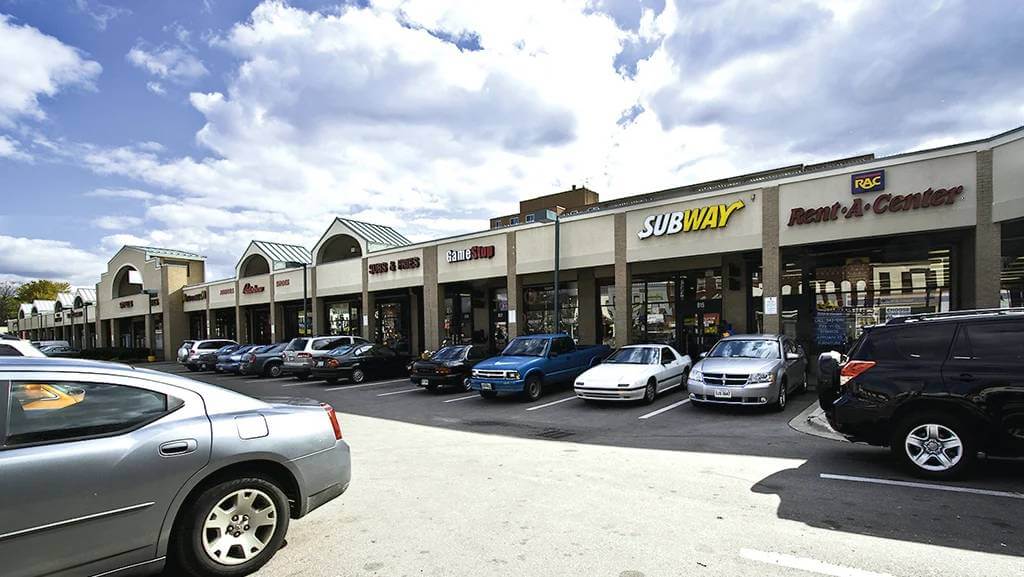
Storefront property on the street or in a strip mall
A regular storefront is a very common type of space for martial arts school. You can find those on a regular commercial street, mixed with other stores, or in a strip mall which are common across the US.
There are several advantages to a regular storefront – it’s very visible, and often next to other stores that have foot traffic and thus create brand awareness just by being there. People walking by will see your dojo and potentially become intrigued to walk in or come back later.
In the case of a strip mall, you would typically have plenty of parking as well, as strip malls have a dedicated parking space. Parking could be a concern with regular street storefronts, as street parking can be tight in popular commercial areas.
Remember, if people can’t easily and consistently get to your dojo, they will eventually stop coming or switch to a different school where it’s not an issue.
Let’s look at some numbers for different places in the US for storefronts:
- Austin, TX: Starting at $2 / sqft = $6,000 / monthly lease.
- San Diego, CA: Starting at $1.5 / sqft = $4,500 / monthly lease.
- Atlanta, GA: Starting at $1.5 / sqft = $4,500 / monthly lease.
- New York, NY: Starting at $3 / sqft = $9,000 / monthly lease.
- Minneapolis, MN: Starting at $1 / sqft = $3,000 / monthly lease.
You can use websites such as Property Shark or LoopNet to get a quick sense of the prices in your area.
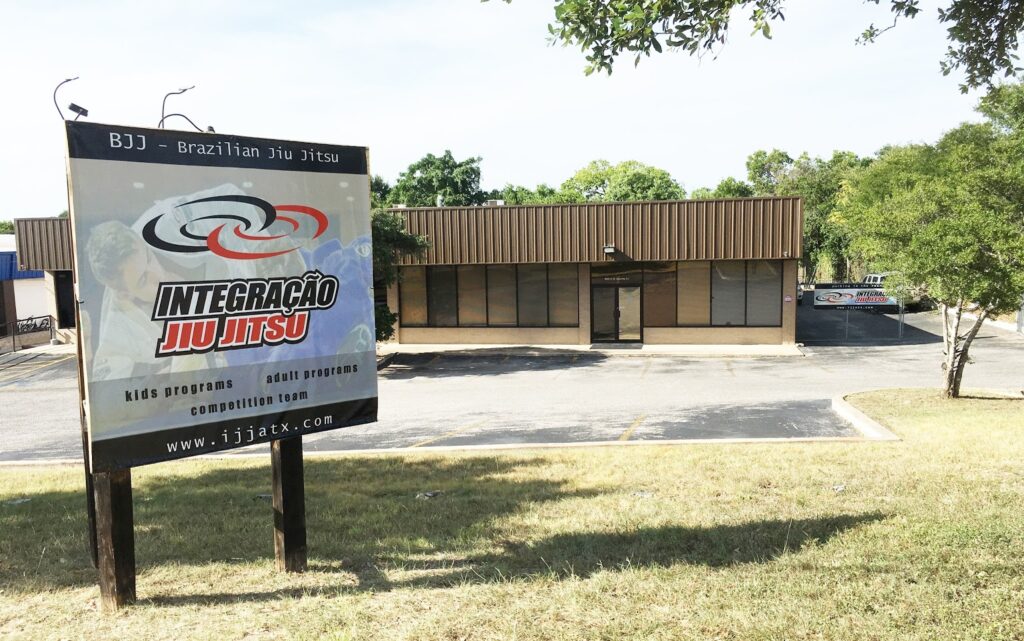
Industrial Properties
Industrial spaces are quite popular for martial arts schools, especially in more expensive cities, where regular retail space is expensive. The main benefit is that you can find a much bigger space for much less per square foot.
On the other hand, industrial properties receive very little to no foot traffic, as industrial zones are intentionally far from residential areas and the main commercial areas where land value is very high. This means that your school will have basically no visibility in an industrial space, and thus you will lose on a potential organic channel of acquiring members.
That might not be a big concern nowadays, with most people doing their research for schools online, however there’s also the perception aspect with industrial areas – where it feels more abandoned and isolated, less visually appealing and potentially has higher crime rates.
Another disadvantage is that industrial spaces are typically bigger than retail spaces – that means that even if it’s cheaper per sqft, you might only have access to spaces bigger than you actually need.
Let’s look at some numbers for industrial properties in the same cities we examined above:
- Austin, TX: Starting at $1 / sqft = $3,000 / monthly lease.
- San Diego, CA: Starting at $1 / sqft = $3,000 / monthly lease.
- Atlanta, GA: Starting at $0.65 / sqft = $1,950 / monthly lease.
- New York, NY: Starting at $2 / sqft = $6,000 / monthly lease.
- Minneapolis, MN: Starting at $0.65 / sqft = $1,950 / monthly lease.
Certainly cheaper compared to retail storefront space. Another factor to consider is accessibility with a car / public transport. Industrial areas tend to have less public transport availability, making it less accessible in cities where public transport is commonly used. It’s also usually further away from residential areas, making for a longer drive for most people, but that might balance out by industrial areas having less traffic compared to retail ones. You should try to see for yourself how easy it is to get to a property you have your eye on before committing to a lease.
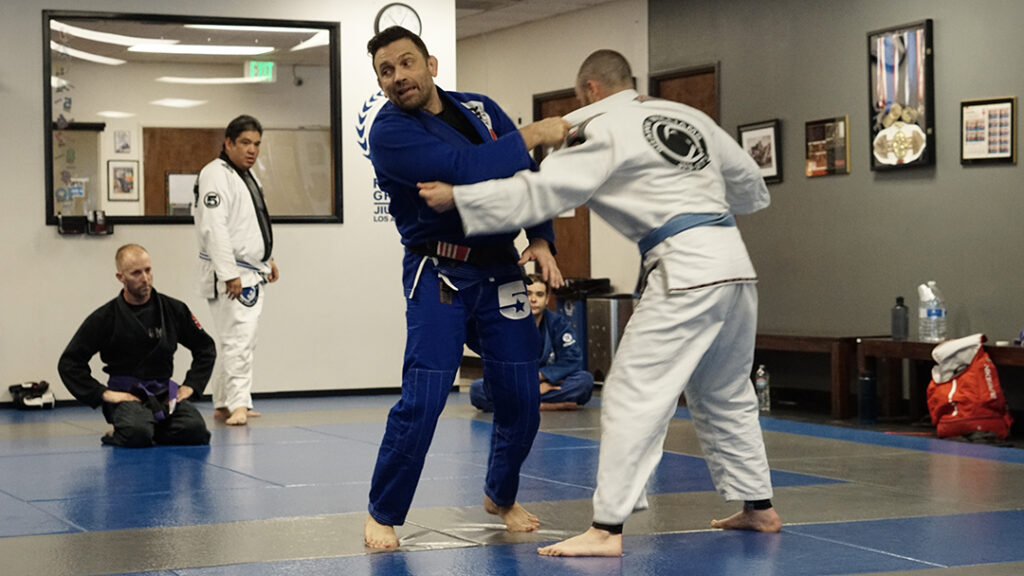
Office Space
The last common option is renting out an office space and converting it into a dojo. This might require knocking down some walls, or finding an open-space layout. Office spaces are commonly used in urbanly dense areas, where storefronts are at a premium (cities like NYC and LA for example).
Somewhat similar to industrial spaces in this regard, office spaces rarely have outside visibility and will not benefit from nearby foot traffic for the most part. The exceptions are open office complexes, where all offices have a door facing the outside, which is somewhat similar to strip malls. However, even then those typically get much less foot traffic.
Let’s take a look at office spaces in the cities we’ve been tracking above:
- Austin, TX: Starting at $2 / sqft = $6,000 / monthly lease.
- San Diego, CA: Starting at $1.5 / sqft = $4,500 / monthly lease.
- Atlanta, GA: Starting at $1.5 / sqft = $4,500 / monthly lease.
- New York, NY: Starting at $3 / sqft = $9,000 / monthly lease.
- Minneapolis, MN: Starting at $1 / sqft = $3,000 / monthly lease.
Office spaces appear to be pretty much on par on average with retail space. This can vary a lot depending on the neighbourhood you’re looking to lease in, and other amenities (parking availability, secure lobby, etc).
When researching a spot for your new school, it’s important to consider all the factors above – accessibility, parking, visibility, neighborhood, etc – and balance it out with the price. Additionally, it’s key to figure out the average cost of martial arts classes that you’ll be providing and if it’s a viable business based on the demand, and lease rate.
Budget Option – Renting space from an existing school
There’s another option which might work when just starting out before you have a big group of students – renting space inside an existing fitness facility or martial arts school. Some schools have multiple mat areas, or do not utilize their existing mat area every day, and you could sublease from them for just times of your classes for much less than it would cost to lease your own space.
The downside is that it looks less professional to be running a class from inside someone else’s business, and you will need to adjust your schedule to accommodate theirs. You might need to bring in your own mats and equipment still.
Conversely, you could rent out your mat space during the times you don’t have a class on, and recoup some of your rental costs. In some cases, the sport / martial art you’ll be renting to could be complementary to yours and increase your appeal to prospective students (such as yoga or wrestling class, and so forth).
Although this would not be a budget option, you may be able to see if there are any existing martial arts businesses for sale in your area. Someone may be wanting to retire, or be part of a joint venture.
Martial Arts Start-up and Recurring Costs
The property lease is one of the biggest cost components of a martial arts school, but there is much more to consider. Other costs can be split into two buckets to build your budget –
- Start-up and one-time costs – the costs you incur before / when you open your schools, for things that would last a while, such as furniture, equipment, construction materials, etc.
- Recurring Costs – Costs that recur on a regular basis – either monthly or annually and include things such as utilities, insurance and so forth.
Start-up and one-time costs
Unless you are taking over for another martial arts school, your new space will require some work to get it ready for training.
For instance, you might need to knock down some walls and pull some floor carpets. Convert one or two of the rooms into changing rooms. Potentially install a shower. People have different requirements for what they would like to offer in their school – make a list of everything and research the cost of both materials and labor (if it’s something you’re not able to do yourself).
One of the biggest expenses for a new dojo is the floor mats. There are two aspects to that – the actual mats and a subfloor underneath for additional shock absorption.
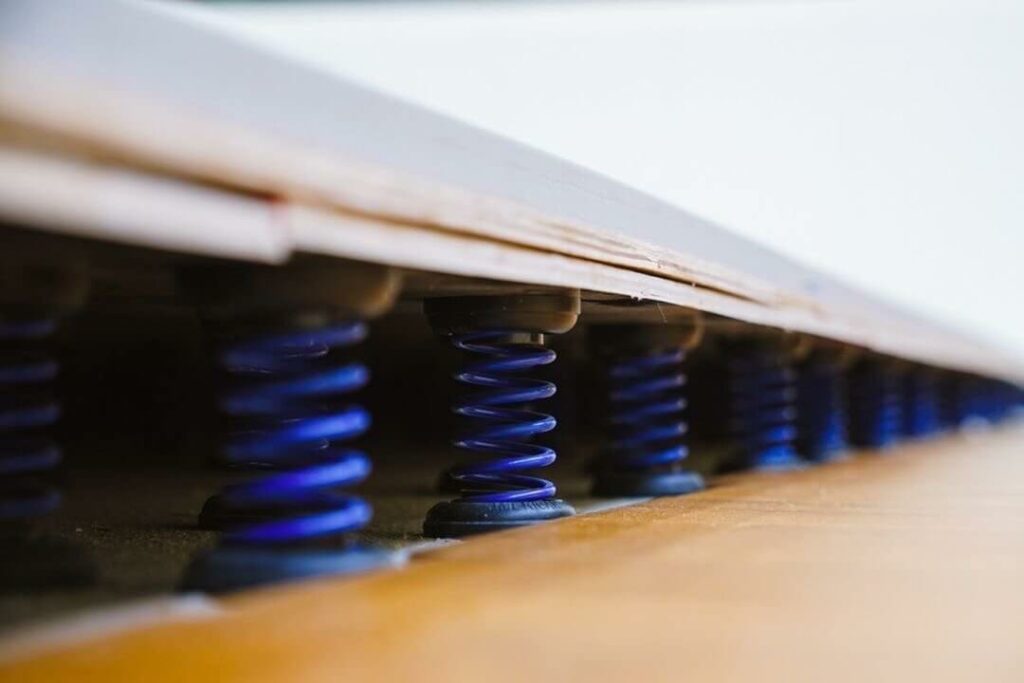
Subflooring
For most arts, a padded software or foam blocks would be sufficient. For sports with higher impact throws / takedown, you should consider putting in a spring system to protect your students.
Continuing with 1500 sqft of mat space as our baseline, we can look at example pricing from FUJI Mats for all options:
- Sub-mat pad: $675 / 900 sqft = $1,125 / 1500 sqft
- Subfloor foam blocks: $249 / 400 sqft = $934 / 1500 sqft
- Subfloor spring system: $8.25 / sqft = $12,375 / 1500 sqft (Expensive!)
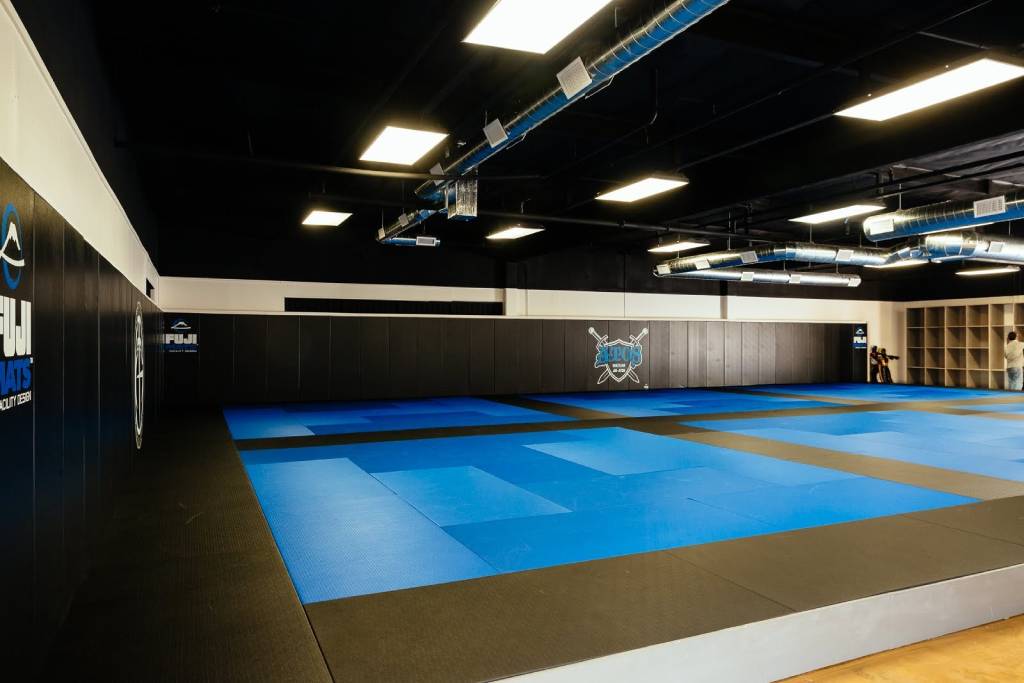
Floor Mats
- 1” Mats (good for most striking arts) – $115 / 21.5 sqft ~ $8,000 for 1500 sqft
- 1.5” Mats (good for Judo, BJJ, Wrestling) – $125 / 21.5 sqft ~ $8750 for 1500 sqft
You also need to budget for some surplus for the edges. Considering all of the above, you should budget around $10,000 for your mats for a 1500 sqft mat area. Budget a little more for the edges, if you want to frame it with wood panels.
Wall Padding
If your mat area is adjacent to a wall, you will want to put up wall pads to prevent injuries when students inevitably crash into the wall. For a 1500 sqft mat area, assuming a square area, each side is about 39 ft. A 2’ wide wall pad runs about $64 for a 4’ tall panel, and $80 for a 6’ panel. The cost of wall padding would then depending on how many sides you need to cover:
- 1 side = $2,500 – $3,120 (4’ / 6’ tall)
- 2 sides = $5,000 – $6,240 (4’ / 6’ tall)
- 3 sides = $7,500 – $9,360 (4’ / 6’ tall)
Overall it would run you an additional $2,500-$9,360 to add wall padding, a significant additional expense.
Furniture
For the school to look inviting and professional, you will also need some basic furniture – a front desk, chairs / sofas for the waiting area, benches for changing rooms. If you will have a separate back office room, you will need a desk and chairs there, as well as a cabinet for paperwork and office supplies. You can expect to spend an additional $1,000 – $1,500 on furniture.
Renovations
Adapting the property space to your needs could include things such as taking down walls (for the mat area), putting up walls (for the changing rooms / back office), changing the lighting, and any other improvements to the space you would like to make. This can vary a lot, and ideally you’ll find a space that requires minimal modifications, but it’s another important piece to budget for depending on your needs. You might want to receive an estimate from a professional contractor if it’s something that’s outside of your own DIY abilities.
Training Equipment
Different arts have different equipment used in training. From shin guards and headgear, to stick weapons and punching bags. You should make a list of the equipment you would reasonably need to start with, and how much it would cost.
One piece of equipment that almost all arts need to stock up on is the training uniform. New beginners who don’t already own a uniform will often rely on you to provide them with their first uniform and belt. This is actually an opportunity to make a bit of profit, as buying wholesale allows you to acquire uniforms for cheaper than is available at retail, however you need to acquire the initial stock in all sizes which should factor into your budget.
Lease deposit
The deposit you put when you start the lease is not technically a cost, however you do need that money available, and you won’t get it back until you end the lease, so we need to budget for it.
The deposit is typically one month of the lease, so between $1,950 to $6,000 depending on location.
Recurring Costs for Martial Arts Schools
The biggest recurring cost is the rent which we covered earlier. There are a few other items you need to budget for:
- Utilities (Electricity, lightning, garbage disposal)
- Internet access
- Insurance
- Admin
- Marketing and Website
- Business registration and fees
Utilities
Electricity costs for a 3,000 sqft facility could range between $100-$150 a month depending on a couple of factors. If you have high ceilings (which is common for industrial spaces), heating / cooling the space could add quite a bit to your electric bill at the end of the month.
Water costs can also vary in case you offer showers, and potentially run laundry on site. Many schools now have a laundry machine for loaner gis and some even offer it as a paid service to members who don’t have the time to wash their uniforms before the next session, or as a convenience option. You can expect to pay another $20-$30 for water and sewage depending on how much you use.
Depending on location, you can expect to pay $15-$30 a month for solid waste disposal (garbage collection by the city).
Note: Depending on your lease, some of those utilities might be included in the lease costs (though likely not electricity).
Internet Service
To be able to run your business software and handle inbound contact from prospects and members during your time at the dojo, you would need an internet connection. For some people, tethering your phone connection would be enough, but in some cases you would want to install internet service at the school.
Due to various reasons, none of which is particularly good, business internet costs much more than residential internet and you’ll receive a slower connection for your money. It’s just the way it is in most cities in the US. Expect to pay at least $100 / month for internet access.
Insurance
Martial arts involve dynamic, athletic movements, and in some cases live sparring between 2 grown adults. Injuries are bound to happen. To protect yourself and your business from being on the hook for injury or accident that occurs in your facility, you need to obtain and pay for the proper insurance.
You can expect to pay around $10 per member annually, with a minimum of around $450 (annually). Some martial arts organizations provide insurance as part of the membership benefits (for example, USA Judo and AAU Karate). To learn more, check out our extensive article on martial arts insurance.
Administration
The day-to-day operations of your school include things such as signing-up new members and having them sign waivers, collecting membership fees.
Today most schools now use member management software specific to fitness gyms or martial arts schools, that takes care of all of the above (check out ours).
These things get tedious really fast, so it’s important that you have martial arts software that supports digital document signing and signup forms. This minimizes the administrative work you have to do to process and file these documents — in fact, it’s mostly automated for you with the right system!
Whenever you want to know the health of your business, or do some light accounting or other business work, easy-to-read business dashboards and reports are a must-have.
Marketing and website
To grow and succeed as a business, martial arts schools need to invest in marketing in order to attract new members. This can include things such as running online ads, creating online content, developing local awareness and recognition through reach out programs and more.
Whether you start spending on marketing from the very beginning, is up to you and your approach to the subject matter. We’ve covered martial arts marketing strategies and campaigns extensively in our resource library.
At the very least, you need a website. Most prospects now start their research online, and their first interaction with your school is through your website. There are several excellent tools that allow you to create a good looking website for relatively cheap, such as Squarespace…
Or you can use the website we give out for 100% as part of our school management software. It is SEO optimized, well-designed, easy to set up, and ready to collect leads for you 24/7.
However you go about it, creating a website is an important part of being able to reach prospects for your school.
Business registration and fees
Martial arts dojos are businesses that are subject to all the same laws and regulations that most businesses are held to. Businesses, by law, are required to be registered. Registration laws and fees vary by state, but here are a couple of examples:
- Businesses in Florida are subject to a $35.00 filing fee followed by a $150.00 ongoing annual fee to continue operation after the initial filing.
- California’s filing fee will run you $100.00 along with $25.00 annual fees and, unlike Florida, an $800.00 minimum franchise tax.
- New York charges a $125.00 filing fee but only costs $9.00 every two years to continue operation with a franchise tax that is based on your total income and capital.
In some states, there are local regulations about the permits you need to legally open and operate your dojo and teach martial arts. Like the registration fees, these licenses and permits vary by state and, in some cases, even vary by city. Check out your local regulations as they relate to the operations of a martial arts school.
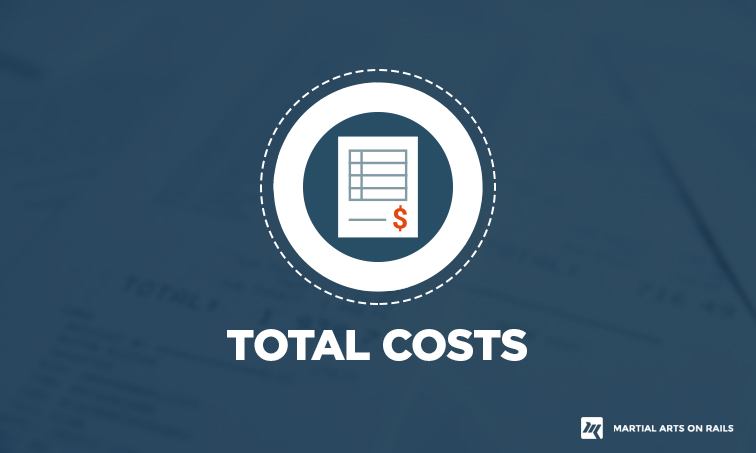
Creating Your Budget
We’ve covered all the major cost components of opening and running a martial arts school. There are some one-off or unexpected expenses that are not included, but it should give us a good sense at what we need realistically for a 3,000 sqft school. Let’s sum everything up:
Start-up costs:
- Sub-floor and mats: $10,000
- Wall padding: $2,500
- Furniture: $1,000
- Renovation: $1,000
- Training equipment (including uniforms): $1,000
- Business registration: Starting at $35
- Lease deposit: $1,950 – $6,000
Recurring Costs (per month):
- Rent: $1,950 – $6,000 (depending on location)
- Utilities: $150
- Internet: $100
- Insurance: $40
- Admin: $60
- Website: $18
- Business registration: Starting at $10 (annual payment divided by 12)
Total:
- Start-up costs: $17,500 – $21,500 (rounded)
- Recurring costs: $2,320 – $6,270
We’re done yet! Unless you already have a significant existing member base to draw on, you should expect to not break even for quite a while. At the very least, you should budget for 6 months of expenses in your starting capital to avoid running out of funds before you’re able to break even.
That means that in order to open a new martial arts dojo, on average we would need:
$17,500 + 6 x $3,500 = $38,500 (we used $3,500 as an average monthly number).
What we didn’t touch on yet, as it’s very dependent on your personal situation and whether you’ll be working while working a job while running your school, is how much you would need for basic living expenses. The above number only covers the costs of starting and running the school!
Realistically, you’re looking at around $50,000 in capital to start a new martial arts school.
Conversely, if you’re able to generate income through a job or other source while running the school, and you have some left over after your basic living expenses, it can cover some (or even all) of your monthly costs, reducing your initial capital requirements.
How To Fund A Martial Arts School
The numbers above might seem daunting to most young, aspiring martial artists. Here are some basic ideas on how you could fund it even if you don’t have the capital upfront.
Business Loans
The amount above might sound significant if you don’t have any savings, but is actually quite common for starting a new business. Most people should be able to acquire a loan for that amount, and you can start your search by looking at SBA loans.
There’s an element of risk here, in that if the school doesn’t work out and eventually shuts down, you’re still on the hook for the remaining loan amount. However, because the loan repayment is spread over many years, it should be feasible to pay it back even if it doesn’t work out, and if you believe in your ability to run a successful school, this is a calculated risk that you should consider taking.
Working another job while running a school
This is a more demanding option but it reduces the risk of relying on a loan by staying within your means. If you’re able to generate additional income while running a school by working a full or part-time job, you might be able to finance most of it without significant initial capital (you still need to cover the start-up costs though).
Generating revenue with seminars
This option is available for well known practitioners / competitors who are in demand for seminars. Even if you’re not at the very top of your sport, if you have a unique approach or consistent results, there will be an audience for your instruction that you can offer to other martial arts schools by running a seminar at their location.
You could take 1 or 2 weekends a month off from your school and travel to other places to do a seminar to generate some income to tide you over.
Starting Smaller
The above numbers are heavily correlated to the size of the school. You can cost the costs by around 20% by going with a school that is 2400 sqft instead of 3000 sqft. There are many smaller martial arts schools that are doing quite well. Potentially, you can start with a smaller space in a larger complex that has the option of leasing nearby spaces later, organically growing your space as your business grows.
Opening a Martial Arts School
What we’ve covered here is a substantial portion of what it takes to open a martial arts school, but it is not everything you need to know.
You still need to learn these business skills, and more.
- Structure your programs properly (including successful martial arts pricing)
- Creating the proper business structure for your schol
- Finding and purchasing the right liability and business insurance
- How to manage the program from growth
Read our article on how to open a martial arts school to learn everything you need to know to get your dojo up and running.
Conclusion: Rise to the Challenge
Starting a new martial arts school is exciting but scary at the same time. It’s important to be realistic about what it requires in order to plan for it accordingly. I hope this article gave you a sense of the financial requirements of opening your own school.
If you do decide to open your own school, check out our martial arts management software. Many of our users are new school owners who credit much of their success to running their school in a professional way with the help of our software.
 Gym Owner Statistics: The State of Gyms, Member Trends, and Usage Data
Gym Owner Statistics: The State of Gyms, Member Trends, and Usage Data



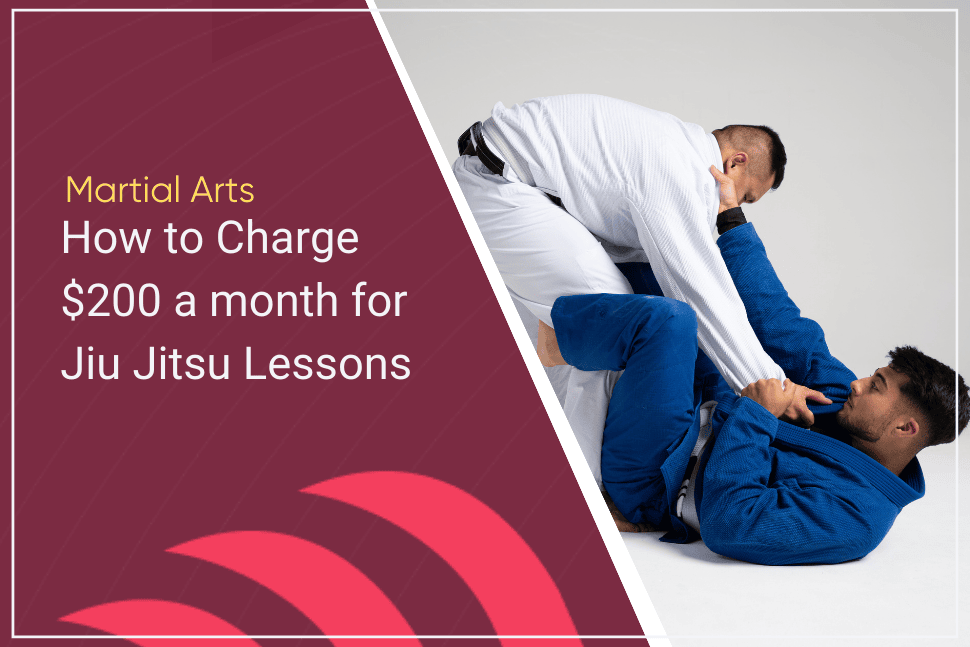
 EN (English)
EN (English)
 JA (日本語)
JA (日本語)